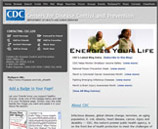State of CDC - Community
Interactive tools
At CDC, we strive to make CDC′s content, tools, and services available when, where, and how users want them. To do so, we use a number of interactive media.
To meet the increasing demand for health information accessibility by the public, CDC′s broadcast activities have evolved from instructional films and distance learning programs to visually appealing direct–to–consumer products, including the launch of CDC–TV. CDC′s broadcast and video productions offer live satellite training on a variety of health topics and fills capacity for timely press conferences and media interviews with CDC′s public health professionals. The agency′s broadcast and video capability has extended the reach of health information both domestically and globally.
Health-e-Cards: CDC is exploring new channels that allow CDC.gov users to create personalized content to accompany health messages. Users can enter an e-mail address and send a colorful greeting that encourages healthy living, promotes safe activities, or celebrates health- and safety- related events. Please visit the CDC Health-e-Cards site to send a friend or family member a card.
Widgets: CDC is building new tools to allow partners and constituents the ability to use CDC.gov information in new places. Widgets, also called gadgets, are tools users can add to a blog, social network profile or other webpage. Each CDC widget contains targeted health- or safety- related, information from CDC.gov that can be accessed without having to go to the CDC website. View current CDC widgets by clicking on the image.
Podcasts: CDC is using podcasts as a new method of distributing audio and video files over the Internet for playback on personal devices or computers. By making CDC information available in new formats, CDC.gov users can now access relevant health information anytime from their personal devices, subscribe to podcasts series that are of particular interest, or watch health videos from their computers.
Blogs: CDC is using blogs to empower constituents to connect with and share health information, as well as to engage public health professionals in meaningful dialogues. CDC launched the Health Marketing Musings blog in June 2006, and has been using this interactive platform to discuss issues related to new media, global health, consumer empowerment and many more topics. In other outreach to the blogosphere, CDC has had several webinars with blog writers to provide credible scientific information and research on which messages are effective in encouraging behavior change.
CDC′s virtual world presence
CDC is creating new ways of providing meaningful and credible health information to our constituents. The immersive and interactive experience of virtual worlds makes this platform an ideal place to encourage modeling, or practicing, of health behaviors. Modeling is an activity that proves to lead to changes in behavior. CDC currently has activities in two virtual worlds:
Whyville and Second Life.
Whyville: CDC collaborated with Whyville, a popular virtual world for children aged 8—11-years-old, to promote seasonal flu vaccinations to Whyvillian children and their grandparents.This year there were more than 40,000 “virtual” vaccinations, and nearly 2,000 grandparents participated in the in-world activities, between November 2007 and mid-January 2008. The exercise also served to increase awareness about the importance of seasonal flu vaccination before and during the 2007—2008 flu season.
Second Life: A popular virtual world where members can create an avatar and interact with other members. CDC is currently working on building an island in Second Life where avatars can interact with health content, get health-related information, and ask questions.
MySpace: CDC networks with MySpace users to provide MySpace friends with relevant health and safety information. On the CDC MySpace site, users can view relevant and timely blogs, watch CDC videos, upload campaign badges to display on their individual MySpace pages, and much more.
Mobile devices and Applications

CDC is exploring a number of different ways that mobile phones can be used to disseminate health information and encourage health behaviors. By providing access via mobile phones, CDC can explore ways to target diverse audiences with “just in time” messaging for health decisions. Ongoing projects include activities related to diabetes and smoking cessation.
Applications
E-mail Subscriptions/RSS Feeds: CDC is exploring ways to provide automated alerts when CDC.gov content is updated. By subscribing to e-mail updates or RSS feeds, CDC.gov users can be notified when topic-specific content is update.
Related Links
State of CDC
Contact Us:
- Centers for Disease Control and Prevention
1600 Clifton Rd
Atlanta, GA 30333 - 800-CDC-INFO
(800-232-4636)
TTY: (888) 232-6348
24 Hours/Every Day - cdcinfo@cdc.gov










